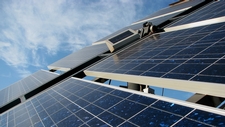Renewable
Supporting

TEKS Objective
The student is expected to identify and classify Earth's renewable resources, including air, plants, water, and animals; and nonrenewable resources, including coal, oil, and natural gas; and the importance of conservation.
Essential Understanding
The students know that Earth consists of useful resources and its surface is constantly changing.
Science Background
Atlas of Population and Environment: American Association for the Advancement of Science (website) – Provides a detailed look at resources such as freshwater, farmland, ecosystems and biodiversity (plants and animals).
List of Natural Non-Renewable & Renewable Resources: eHow.com (website) - Information about natural resources that are renewable (e.g., wind, solar and geothermal energy) and non-renewable, such as fossil fuels.
List of Natural Non-Renewable & Renewable Resources
by Debbie Pollitt, eHow.com
Where Did that Pencil Come From? Econedlink.org (website) - Students determine what goods can be produced using natural resources, identify which natural resources contribute to the production of a particular item, and identify natural resources on a map.
Signature Lesson
What are Renewable Resources? Pencils.com (website) - Students identify the concept and value of renewable resources and classify renewable and non-renewable resources.
- Supporting Lessons
- Extensions
- Assessment Ideas
- Literature Connections
- Related
TEKS - Additional Resources
Supporting Lessons
Renewable & Nonrenewable Resources Lesson Plan: Penn State University (PDF) - Students describe a natural resource and identify renewable and nonrenewable resources in a given environment.
Renewable Energy Sources: Science NetLinks (website) - Students investigate a variety of renewable energy resources, and explore the benefits and drawbacks of each.
Renewable Energy Sources
Science NetLinks, www.sciencenetlinks.com
Natural Resources, Renewable vs. Nonrenewable: LessonPlansPage.com (website) - Explains the importance of natural resources and the characteristics of renewable and non-renewable resources.
Natural Resources, Renewable vs. Nonrenewable
by Cynthia Gaucin, LessonPlansPage.com
Elaboration Lessons and Extensions
Developing an Object or Tool: BioEd Online (Website) - Student teams work together to establish the process through which a natural resource (e.g., a tree) becomes a finished product (e.g., a wooden chair). Teacher background included.
Assessment Ideas
- Assign each student a natural resource, or allow students to choose their own.
- Have students draw pictures to show how this resource is processed to produce a finished good.
- Have each student write a short description of the process he or she has just illustrated.
Literature Connections
Making Good Choices about Renewable Resources. Nagle, Jeanne (ISBN-10: 1435856023)
A Refreshing Look at Renewable Energy with Max Axiom, Super Scientist. Krohn, Katherine E. (ISBN-10: 1429639024)
Sustaining Our Natural Resources. Green, Jen (ISBN-10: 1410943283)
The Earth's Resources: Renewable and Non-Renewable. Harman, Rebecca (ISBN-10: 1403470618)
Additional Resources
Digital Picture Water Source Hunt: Digital Wish (website) - Students create a PowerPoint presentation and a book to demonstrate their understanding of where water comes from and how we use water in our everyday lives.
Digital Picture Water Source Hunt
Digital Wish, www.digitalwish.com
TEKS Navigation
Grade 4
Need Assistance?
If you need help or have a question please use the links below to help resolve your problem.

Comments